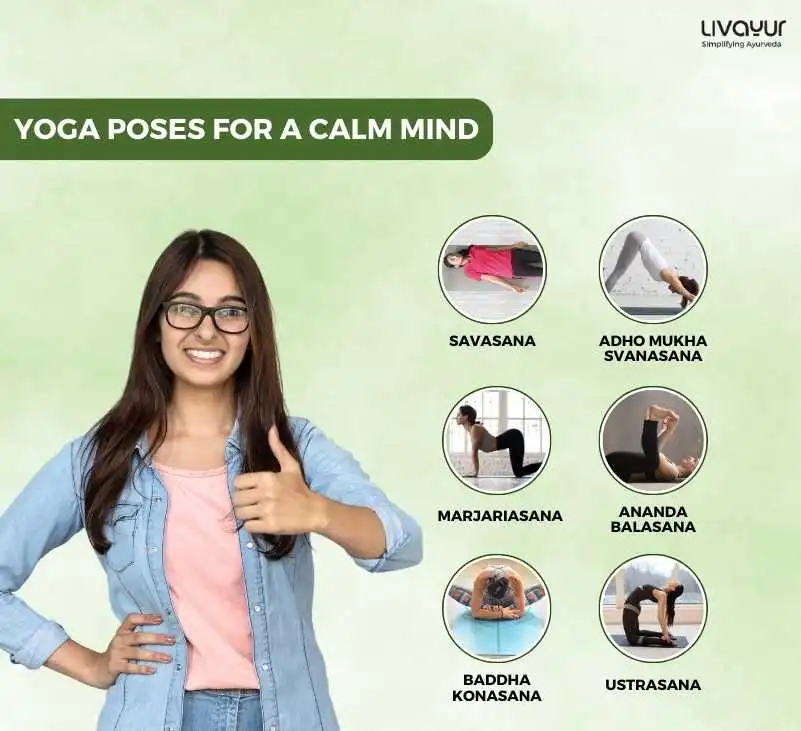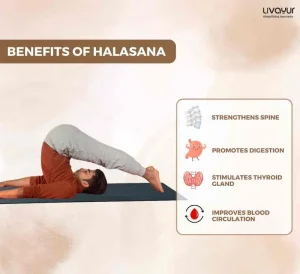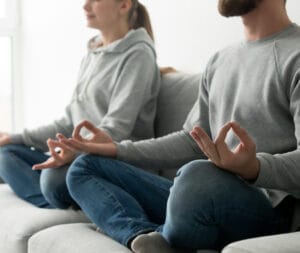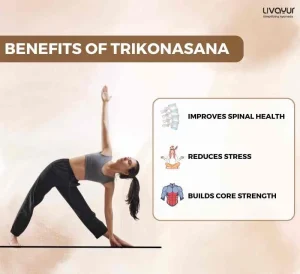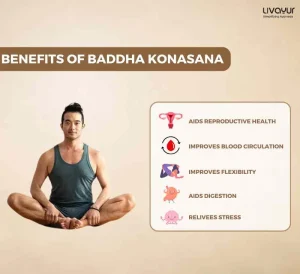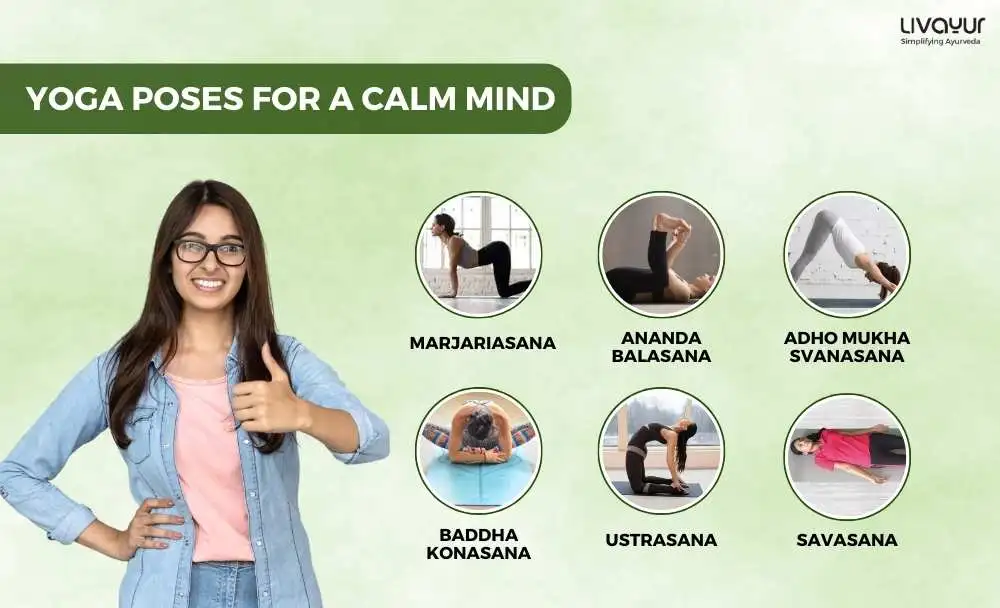
Is stress beating you down? Are you seeking happiness and a stress-free life? Then you have come to the right place. We’ll educate you on how to manage stress and feel happy with the power of yoga. Yogasana can serve as an effective stress-buster. There are many yoga poses that if practiced regularly, can help elevate your mood, reduce stress, and bring a sense of happiness and relaxation.
In this article, we will learn about the various yoga poses for happiness. Practicing yoga for a calmer mind can enrich the overall quality of your life. Read on to learn how yoga can bring you out of the hellfire of stress and anxiety and give you a blissful life:
How yoga helps in relaxing the mind
1. Breath Control
Yoga emphasizes conscious breathing techniques that calm the nervous system. Deep, controlled breaths reduce stress and anxiety, promoting relaxation. [1]
2. Balancing Nervous Systems
Yoga operates by shifting the body’s response from the flight-or-fight reflex of the sympathetic nervous system to the calming, restorative mode of the parasympathetic system. This shift reduces heart rate, blood pressure, and cortisol levels, fostering a state of relaxation. [1]
3. Enhanced Mental Well-being
Regular yoga practice aims for mental tranquility and overall well-being. It fosters feelings of relaxation, self-confidence, and optimism. By inhibiting stress-related brain areas and stimulating pleasure centers, yoga diminishes anxiety, heart rate, and blood pressure. [1]
4. Mood Improvement
Practicing yoga for happiness positively influences serotonin levels while reducing cortisol and monoamine oxidase. This makes it an appealing option for managing depression, stress, and anxiety, often preferred due to its fewer side effects compared to medications. [1]
5. Stress Relief and Better Sleep
Yoga for happiness and relaxation serves as a counterbalance to modern life’s intense stimuli, offering restorative postures and meditation that induce Pratyahara, quieting the senses and fostering improved sleep patterns. [1]
6. Release of Tension
Holding yoga poses for happiness and consciously relaxing the body helps release stored tension. This physical release has a direct impact on mental stress and tension.
7. Enhanced Self-Awareness
Through yoga, individuals often become more attuned to their bodies and emotions. This increased self-awareness allows for better stress management and relaxation. Yoga and meditation for happiness can sharpen this sense of self-awareness all the more.
Yoga Poses to Boost Happiness
1. Adho Mukha Svanasana:
Also known as the downward-facing dog pose, this yogasana can help to elevate your mood immediately. It helps to calm the nervous system, improve blood circulation, and alleviate stress, which makes you feel happy. [4]
How to do Adho Mukha Svanasana?
Step 1: Set yourself up on your fours like a table and take in a deep breath.
Step 2: Lift your hips and straighten your legs as you exhale.
Step 3: Keep your hands pressed to the ground as you form an inverted V shape with your body.
Step 4: Now, take a few deep breaths while gazing at your navel.
Step 5: As you exhale, come back to the table pose.
2. Ustrasana:
Ustrasana is also known as the camel pose. This yoga pose is highly effective in alleviating mental fatigue, anxiety, stress, and depression. This yoga can lift your mood and make you feel happy and relaxed.[6] It also helps to stretch the muscles of your thorax, abdomen, inguinal region, and thighs and boost the blood circulation in your body, thereby helping you feel energized.
How to do Ustrasana?
Step 1: Kneel on your knees with your hands on your hips.
Step 2: Inhale and place your palms on your feet, arching back from your tailbone.
Step 3: Gently exhale and return to the original position.
Step 4: Repeat this yoga pose three to four times.
3. Baddha Konasana:
Also known as the butterfly pose, Baddha Konasana is known to alleviate stress and negative thoughts from the mind. This yoga pose helps create a safe and calm space around you that makes you feel positive, relaxed and happy. [7]
How to do Baddha Konasana?
Step 1: Sit with your spine straight with your feet placed down to your pelvis so that the soles of your feet touch each other.
Step 2: With your hands, grab your feet and push the heels close to your genitals.
Step 3: Take a deep breath in and aim to touch the floor with your thighs and knees as you exhale.
Step 4: Begin fluttering your legs like a butterfly, gradually increasing the speed.
Step 5: Continue to take deep breaths while keeping your spine erect. Then, return to your normal position after 5-10 minutes.
4. Ananda Balasana:
Ananda Balasana is also known as the happy child’s pose. As the name suggests, this yoga asana helps to bring joy and positivity while balancing your emotional and physical health. [4] It is a highly effective yoga pose in dealing with anxiety and relaxing your body.
How to do Ananda Balasana?
Step 1: Lie flat on your back and bend your knees at a 90-degree angle towards your chest. Turn your feet up towards the ceiling with the soles of your feet facing up.
Step 2: Grab and grasp the inside or outside of your feet as you reach forward. Shift your knees towards your armpits by spreading them apart.
Step 3: Gently rock from side to side while flexing your heels into your hand like a happy baby. Stay in this position for a few deep breaths and then come back to the original position.
5. Marjariasana:
Marjariasana, also known as cat-cow pose, helps soothe your nervous system, bring positive energy, and calm the constant fluctuations in your mind. It involves synchronized breath movements that help alleviate stress and bring a sense of relaxation to your mind and body.
How to do Marjariasana?
Step 1: Get down on your hands and knees and make a table pose. Maintain a hip-width distance between your hands and legs and keep them perpendicular to the floor.
Step 2: Take in a deep breath and lower your navel while elevating your chin and head backward.
Step 3: Now, exhale and raise your navel to make an arch while lowering your chin.
Step 4: Do this yoga pose a couple of times and then gently return to your original position.
6. Savasana:
Savasana or corpse pose is one of the best yoga poses to alleviate stress and meditate peacefully. It helps you feel happy and relaxed. [5]
How to do Savasana?
Step 1: In a comfortable position, lie flat on your back with your legs apart.
Step 2: Close your eyes and place your arms alongside your body.
Step 3: Slowly and deeply inhale and exhale. Concentrate on all of your body parts and your breathing rhythm as you meditate.
Step 4: Do this yoga pose for 15-20 minutes, then gradually return your focus to your surroundings.
Who should not perform these poses?
- Pregnant Individuals: Certain poses like deep twists or poses that exert pressure on the abdomen should be avoided during pregnancy as they might risk the safety of the mother and the baby.
- Those with Specific Injuries: Individuals with neck, back, or joint injuries should exercise caution or avoid poses that might strain these areas, potentially worsening the injury.
- High Blood Pressure or Heart Conditions: Poses that involve inversion or intense breath retention may not be suitable for individuals with high blood pressure or heart issues.
- Recent Surgery: People who have undergone recent surgeries should avoid poses that strain or stress the operated area.
- Chronic Health Conditions: Those with chronic health conditions should consult a healthcare professional before attempting these poses to ensure safety and suitability. [2]
Precautions to be taken
- Warm-Up: Begin with gentle warm-up exercises or stretches to prepare the body for yoga poses. This primes the muscles, reducing the risk of strains or injuries during the practice session.
- Awareness of Body Limitations: Respect your body’s limits and avoid pushing beyond comfortable thresholds. Listen to your body and modify poses if needed, especially if you are a beginner or dealing with physical limitations or injuries.
- Proper Technique: Focus on proper form and technique rather than attempting advanced variations. This ensures you are getting the benefits of the pose without risking injury due to incorrect alignment.
- Breathing: Maintain steady, controlled breathing throughout the practice. Avoid holding your breath, as consistent breathing aids in relaxation and prevents unnecessary strain on the body. [3]
FAQs
1. How to calm the mind during yoga?
Achieving mental calm during a yoga session involves simple yet effective techniques. Start by practicing deep, intentional breathing. Inhale through your nostrils, hold briefly, and exhale gradually, ensuring your exhale is longer than your inhale. Concentrate on this rhythmic pattern, allowing your mind to sync with your breath as you transition through different poses.
2. How does yoga relax your mind?
Yoga serves as a powerful tool for stress reduction by fostering relaxation, the antithesis of stress. It positively influences our body, mind, and breathing—three key areas impacted by stress. By engaging in yoga regularly, one proactively nurtures these aspects, preemptively addressing stress rather than waiting to feel overwhelmed.
3. Which are some of the best yoga asanas for mental peace?
Some of the best yoga asanas for mental peace include Viparita Karani, Savasana, Paschimottanasana, Marjaryasana, Setu Bandhasana, and Virabhadrasana.
4. What are the 4 types of minds in yoga?
Yoga delineates the human mind into 16 dimensions, categorized into four primary aspects: buddhi, manas, ahankara, and chitta. These dimensions offer a comprehensive framework to understand the multifaceted nature of the mind, encompassing its cognitive, perceptive, egoistic, and consciousness-driven elements within the realm of yogic philosophy.
5. Does yoga help with overthinking?
Yes, yoga offers effective tools to manage and reduce overthinking. By integrating mind, body, and environment, yoga aids in alleviating stress and anxiety. Specific yoga poses and breathing exercises facilitate a deeper connection between your mental state and physical sensations, enabling you to regulate and eventually control negative thought patterns. The practice allows you to set your pace, gradually empowering you to navigate and calm overactive thoughts through focused breathing and mindful movements.
Conclusion
The practice of specific yoga poses offers an immediate route to a calm and relaxed mind. These poses, from the downward-facing dog to the soothing corpse pose, impact both the body and mind, enhancing emotional well-being and mental tranquility. By engaging in these poses regularly, you can experience improved blood circulation, reduced stress, and a shift from the flight-or-fight response to a state of relaxation. As a holistic practice, yoga serves as an essential tool to combat stress and anxiety, fostering happiness and positivity. Regularly practicing yoga for happiness and relaxation provides an effective pathway to maintain a positive outlook amidst life’s challenges, promoting overall mental and emotional well-being.
Disclaimer
This article has been written purely from a health and wellness perspective and is not a substitute for medical advice.
References
- Exploring the Therapeutic effects of yoga and its ability to increase quality of life
- Yoga for Health: What the Science Says
- Yoga: What You Need To Know
- YOGA FOR MENOPAUSE
- A Study on the Effect of Relaxation Techniques and Shavasana on Stress and Pulse Rates of Medical Students
- Importance of Ustrasana in Present Era
- Stress, Inflammation, and Yoga Practice




